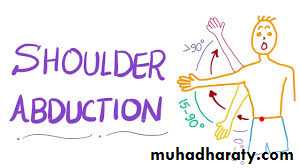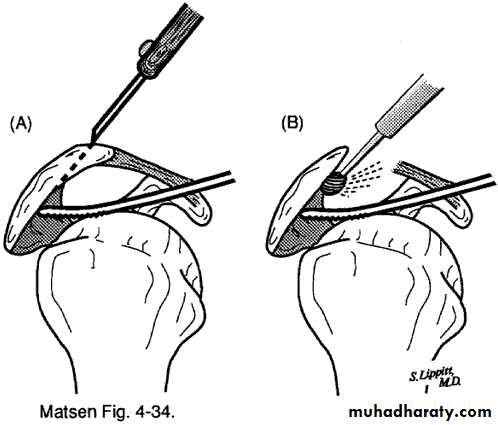Rotator cuff disorders
Dr. Ihsan AlshamyFIBMS Orth.
Anatomy of rotator cuff
Formed by tendons of 1. supraspinatus muscle 2. Infraspinatus muscle3.Subscapularis muscle, the 3 tendons unite to form ( rotator cuff tendon) which pass beneath the coracoacromial ligament, separated from it by Bursa and inserted in head of the humerus. Function : initiation of abduction.Rotator cuff
DeltoidScapula rotation on the chest
pathology
Friction of the rotator cuff under the coracoclavicular ligament occurs in position when the arm is abducted, slightly flexed and internally rotated ; this called ( impingement position), like in cleaning windows
1
2
Osteoarthritis of acromioclavicular joint with osteophytes
3
Subacromial bursitis like in rheumatoid arthritis or Gout
Continuous friction may lead to :
tendinitis or partial tear or complete tearClinical features
Anterior shoulder pain after vigorous activity like swimming , window cleaning, hair grooming
Examination for tendinitis
1- Painful arc test: anterior shoulder pain between 60-120 degree of shoulder abduction, repeating the movement with arm in external rotation is much painless.2. Neers impingement test : flexion abduction internal rotation of the shoulder produce anterior shoulder pain under the acromion process, repeating the maneuver after injection of 10 ml of xylocaine ( local anesthesia) will greatly reduces the pain
Partial and complete tear
The same clinical features of tendinitis but the patient can Not initiates active abduction of the arm; to differentiate between partial and complete tear we inject 10 cc of local anesthesia ( xylocaine) in Subacromial space, if the patient can do active abduction of the arm after the injection means it is partial tear; and if he still can not do abduction it means complete tearDrop arm sign: singe of complete tear
X- ray
-Erosion of greater tuberosity-Upward migration of humeral head
-Osteoarthritis of acromioclavicular joint
MRI
Best method of diagnosis. It shows the cuff tearUltrasound
May show cuff tearTreatment
conservative treatmentAvoidance of impingement position
NSAI
Physiotherapy
Active exercise in position of freedom
If no response to conservative treatment
Subacromial injection of steroidSurgery ( called acrmioplasty)
Indicated in full thickness tearSurgery includes removal of the coracoacromial ligament, removal of osteophytes from the under surface of acromion. It can be done open or arthroscopic.
Biceps tendinitis
Biceps muscle has 2 heads of origin; short head from coracoid process and long head from the glenoid margin, the muscle inserted in the radius bone below elbow, it is responsible for elbow flexion and forearm supination
Biceps tendinitis usually occurs in the long head, either alone or in association with rotator cuff syndrome
Diagnosis
1-Speed test: resisted flexion of the elbow with forearm supinated produce anterior shoulder pain.2-Yergason test: resisted supination of the elbow with forearm flexion will produce anterior shoulder pain.
Treatment
• Conservative : local heat, NSAI, local injection of steroid.• Surgery: include tendon decompression, biceps tenotomy.
Rupture biceps muscle
may occurs in elderly after lifting heavy weight, characterized by bruises and ecchymosis over the proximal arm
Resisted flexion of the elbow will produce lump (Popeye sign)
Treatment: in elderly usually conservative treatment. Young patient need surgical repair of the tendon.


























